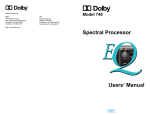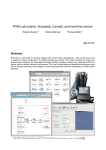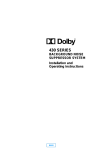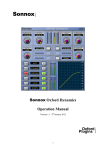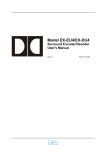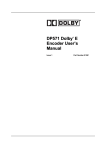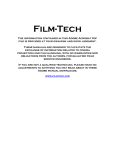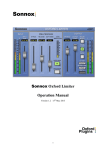Download Dolby Laboratories SDU4 Specifications
Transcript
MODEL SEU4 Surround Encoder Users' Information MAIN USERS' MANUAL FOR MODEL SEU4 SURROUND ENCODER Dolby Laboratories Inc U.S.A. 100 Potrero Avenue, San Francisco, CA 94103-4813 Tel: 415-558-0200; Fax: 415-863-1373 U.K. Wootton Bassett, Wiltshire SN4 8QJ Tel: +44-(0)-1793-842100; Fax: +44-(0)-1793-842101 www.dolby.com WARRANTY INFORMATION, USA: warranty on the product covered by this manual is subject to the limitations and disclaimers set forth in the warranty disclaimer originally shipped with the product and also printed on the back of the invoice. All requests for repairs or information should include the unit serial number to ensure rapid service. Dolby is a registered trademark of Dolby Laboratories. ©1997 Dolby Laboratories SEU4-CE ISSUE 4 S97/11562 Dolby Part No. 91436 MAIN i TABLE OF CONTENTS SECTION 1 INTRODUCTION 1.1 1.2 Introduction ................................................................................................................................. 1-1 Specifications ............................................................................................................................... 1-2 SECTION 2 CONNECTIONS 2.1 2.2 2.2.1 2.2.2 2.3 2.4 2.5 Remote Connector J507 .............................................................................................................. 2-1 Power and Fusing ....................................................................................................................... 2-2 230V-Only SEU4 .......................................................................................................................... 2-2 Multi-Voltage SEU4 .................................................................................................................... 2-2 Ground ......................................................................................................................................... 2-3 Audio ............................................................................................................................................ 2-3 Regulatory Notices ..................................................................................................................... 2-3 SECTION 3 CALIBRATION 3.1 3.2 3.3 General ......................................................................................................................................... 3-1 Items Needed ............................................................................................................................... 3-1 Calibration ................................................................................................................................... 3-1 SECTION 4 BLOCK DIAGRAM ....................................................................................................................................................... 4-1 APPENDIX Dolby Surround: Getting Started Studio Questionnaire Technical Requirements for Dolby Surround in Recording Studios "Phase Correctors" and Dolby Surround MAIN 1-1 SECTION 1 INTRODUCTION 1.1 Introduction The Model SEU4 is used to generate Dolby Surround program material. The SEU4 contains a precision four-to-two spatial encoding network that is used to combine four directionally allocated input signals (Left, Center, Right and Surround) into a two-channel distribution pair. The two-channel output of the SEU4 contains the original four-channel directional information in a matrix encoded form that allows subsequent decoding by suitable consumer or professional decoding devices into four channel materials. The SEU4 encoder is designed to be used in conjunction with the companion SDU4 Surround Decoder. Satisfactory generation of program material for surround encoding requires mixing and monitoring using what is known as the “4-2-4” technique. A fourchannel mix is prepared and sent to the input of the SEU4 Surround Encoder via the mixing console. The SEU4 generates a pair of channels that are recorded for subsequent distribution. Simultaneously, the two-channel material is decoded using the SDU4 and monitored in the mixing environment. This allows mixing engineers to adjust the mix content in real time to fit the final playback environment. The 4-2-4 technique is essential not only to produce successful surround material, but also to guarantee compatibility in conventional stereo and monophonic playback. Typically, the two channels generated by the SEU4 are distributed by conventional stereo means such as consumer video formats and broadcast systems. Listeners who wish to recreate four-channel input material can optionally decode the program material using a surround decoding device. These are being manufactured by many consumer equipment manufacturers and can be identified by a Dolby Surround logo on the equipment. Home decoding of the two-channel output of the SEU4 is considered desirable but optional. The two-channel material from the SEU4 is compatible with non-decoded, two loudspeaker playback. The two-channel output of the SEU4 can also be considered to be mono-compatible provided the original four-channel program material has been allocated in a manner consistent with monophonic playback. Note: The Model SEU4 is not designed for mastering Dolby film sound formats. Dolby film formats can only be produced with a valid Dolby Film Service agreement under supervision of a Dolby Film Sound consultant. For further information please contact Dolby Laboratories. MAIN 1-2 1.2 Specifications Layout: processing to be inserted via EPL input and output connectors. 1U rack-mount unit incorporating a professional surround encoder module, interface circuitry, and power supply. Overall Frequency Response: Signal Connections: 20Hz—20kHz ±1dB (L, C, andR inputs). 100Hz—7kHz ±3dB (surround input). Left, Center, Right and Surround XLR inputs. Lt (Left total) and Rt (Right total) XLR outputs. EPL (External Process Loop) XLR sends and returns. (All XLR connectors wired pin2 “hot.“ For unbalanced operation, at the SEU4 end connect cables exactly as for balanced circuits and unbalance the circuit only at the remote end.) Front Panel Controls and Indicators: Ten screwdriver adjustable trim controls: Left, Center, Right, and Surround input; Lt and Rt External Processor Loop (EPL) send; Lt and Rt EPL return; Lt and Rtmain outputs. Four segment LED meters for each input L,C,R, and S; LED surround active indicator and 2 LEDs for EPL status. Input Circuit: (0 dBr = 0.775V rms) Four balanced floating transformerless inputs. Input gain adjustment will accommodate a range of 300mV (–8.2dBr) to 2V rms (+8.2dBr). Input impedance is greater than 10kohms. Maximum common mode voltage 4 V rms, 5.8 V peak. Output Circuit: Two balanced floating transformerless outputs. Output gain adjustment will accommodate a range of 250mV (–9.8dBr) to 2.5 V (10.2dBr). Output impedance 25ohms. Maximum output voltage +26dBr into balanced 600 ohm load, less into lower impedances. Maximum output +20dBr into unbalanced 600ohm load. External Processor Loop: S/N Ratio: (referenced to Dolby level) Greater than 80dB, CCIR/ARM weighted. Distortion: Total Harmonic Distortion (THD) at themain balanced outputs will not exceed 0.25% into balanced loads 600 ohms or greater at any output level to 12.5V rms. THD at Dolby level at 1kHz with input and output adjusted for 4dBr, 0.1% typical. Ambient Operating Temperature: Up to 40 degrees C. Construction: Two plug in modules: one Dolby surround encoder and one interface module. Fiberglass printed circuit cards, gold-plated edge connectors, solid-state devices throughout. Size: 1 rack unit 43mm (1.75") high, 260mm (10.25") deep behind mounting surface;maximum projection in front of mounting surface 7mm (0.28"). Weight: 5 kg, (11 lb.) Power Requirements: The SEU4 consumes about 20 watts and is designed for operation from a centrally switched power source. 230 V version: 198264 V ac, 50/60 Hz, uses one 20 mm T250 mA fuse. Multi-voltage version: 85-132 V ac, 50/ 60 Hz, uses one 1.25" 500 mA slow-blow fuse, or 187-264 V ac, 50/60 Hz, uses one 20mm T250 mA fuse. A two-channel EPL is provided for interface Specifications subject to change without with other equipment. The loop is engaged notice. by an internal switch and allows external MAIN 2-1 SECTION 2 CONNECTIONS The SEU4 is a one-unit high chassis containing power supply, input/output connectors and two plug-in circuit boards, a Cat. No.338 surround encoder and Cat. No.385 input/ output board. Audio inputs and outputs use three-pin XLR connectors. All inputs and outputs have level adjustments to match studio line levels. The unit has a two-channel external processor loop to allow the insertion of external equipment such as a peak limiter; a link between pins 6 and 7 of the remote control connector on the rear (J507) engages this loop. 2.1 Remote Connector J507 The SEU4 has a 15-pin female D-type connector that provides signals for remote metering and control. For optimum immunity to rf interference, use shielded cable and connect the shield to the metal housing of the male D-connector, not to one of the pins. J507 Pin No. Function 1 (500mV) ................ Surround line in meter point 2 (500mV) ................ Right line in meter point 3 (500mV) ................ Center line in meter point 4 (500mV) ................ Left line in meter point 5 ................................ Link to signal ground to disable surround channel* 6 ................................ Link to signal ground for External Processor Loop On 7 ................................ Signal ground 8 ................................ Chassis ground 9 10 11 12 13 (500mV) .............. LT output meter point 14 (500mV) .............. RT output meter point 15 .............................. Signal ground *J511 on the I/O board is set in ACTIVE HI position when shipped. With J511 set this way, grounding D-connector J507 pin 5 will disable the surround channel. J511 can be changed to accommodate ACTIVE LO control logic; with this setting of J511, grounding D-connector pin 5 will enable the surround channel. MAIN 2-2 2.2 Power and Fusing 2.2.1 230V-Only SEU4 METAL CLIP INSTALLED ON UNUSED SIDE OF CARRIER TOP OPEN THETHE OPEN DOOR DOOR SE FU IER RR CA INSTALL FUSE ACTIVE FUSE Figure 2.1 Fuse compartment, 230V unit Open the fuse compartment door in the AC mains input connector with a small flat blade screwdriver (see Figure 2.1), and check that the fuse has the correct rating (T250mA 20mm time-lag). The fuse carrier must be inserted into the compartment with the orientation as shown. Do not force the carrier into the compartment. Damage will result. 2.2.2 Multi-Voltage SEU4 SPARE FUSE (UPPER) OCTAGONAL PEG OPEN THE DOOR ROUND PEG VOLTAGE SELECTOR WHEEL FUSE ACTIVE FUSE CARRIER (LOWER) FUSE A2F4037 Figure 2.2 Fuse compartment, multi-voltage unit Open the fuse compartment door in the AC mains input connector with a small flat blade screwdriver (see Figure 2.2), and check that the fuse has the correct rating. If necessary, rotate the selector drum until it displays the correct voltage for the installation. (The drum may also be removed and replaced in the desired position. It will only fit one way around.) Snap the fuse compartment door closed . For 85 to 132 Vac use 500 mA 1.25" slow-blow fuse. For 187 to 264 Vac use T250 mA 20mm time-lag fuse. MAIN 2-3 2.3 Ground It is normal practice to connect signal ground to power line ground for many reasons including safety. In the SEU4 they are linked by a jumper on the input/output board inside the unit. On occasion, hum can be reduced by separating the two grounds. If this is necessary, remove the front panel (2 screws on top and 5 along the bottom) and the top cover (2 screws each side), and move the jumper at the rear left of the unit (J510) to the “holder” position. There is a 1 k ohm resistor across the link, so the signal ground is never totally isolated from the chassis. Note that the chassis is always connected to the ground pin of the power line cord; for safety reasons, this ground MUST NEVER be disconnected 2.4 Audio Connections The SEU4 has been designed to interface with professional audio equipment at commonly found studio operating levels. Connections to and from the unit are made using standard 3-Pin XLR-type connectors. Both the input and output stages are electronically balanced with pin 2 being positive and pin 3 being negative. For optimum immunity to radio-frequency interference, cable shields should be connected to the shells of the XLR connectors, not to pin1. For unbalanced operation, at the SEU4 end connect cables exactly as for balanced circuits and unbalance the circuit only at the remote end. 2.5 Regulatory Notices UL Troubleshooting must be performed by trained technicians. Do not attempt to service the unit unless you are qualified to do so. WARNING: Check that the units have been set to the correct supply voltage and that the correct fuses have been installed. To reduce the risk of fire, replace the fuses only with the same type and rating. Do not use a ground-lifting adaptor and never cut the ground pin on the three-prong power plug. MAIN 2-4 UK Connections for United Kingdom: WARNING: THIS APPARATUS MUST BE EARTHED. As the colours of the cores in the mains lead may not correspond with the coloured markings identifying the terminals in your plug, proceed as follows: • The core which is coloured green and yellow must be connected to the terminal in the plug which is marked with the letter E or by the earth symbol , or coloured green or green and yellow. • The core which is coloured blue must be connected to the terminal which is marked with the letter N or coloured black. • The core which is coloured brown must be connected to the terminal which is marked with the letter L or coloured red. EUROPEAN EMC The 230V unit complies with the EMC requirements of EN 50081-1, EN 50082-1, prEN 55103-1 and -2 when installed in an E2 environment in accordance with this manual. MAIN 2-5 IEC NOTICES IMPORTANT SAFETY NOTICE This unit complies with the safety standard IEC65. To ensure safe operation and to guard against potential shock hazard or risk of fire, the following must be observed: • Ensure the voltage selector is set to the correct mains voltage for your supply. • Ensure fuses fitted are the correct rating and type as marked on the unit. • The unit must be earthed by connecting to a correctly wired and earthed power outlet. • The power cord supplied with this unit must be wired as follows: Live—Brown Neutral—Blue Earth—Green/Yellow GB IMPORTANT – NOTE DE SECURITE Ce materiel est conforme à la norme IEC65. Pour vous assurer d'un fonctionnement sans danger et de prévenir tout choc électrique ou tout risque d'incendie, veillez à observer les recommandations suivantes. • Le selecteur de tension doit être placé sur la valeur correspondante à votre alimentation réseau. • Les fusibles doivent correspondre à la valeur indiquée sur le materiel. • Le materiel doit être correctement relié à la terre. • Le cordon secteur livré avec le materiel doit être cablé de la manière suivante: Phase—Brun Neutre—Bleu Terre—Vert/Jaune F WICHTIGER SICHERHEITSHINWEIS Dieses Gerät entspricht der Sicherheitsnorm IEC65. Für das sichere Funktionieren des Gerätes und zur Unfallverhütung (elektrischer Schlag, Feuer) sind die folgenden Regeln unbedingt einzuhalten: • Der Spannungswähler muß auf Ihre Netzspannung eingestellt sein. • Die Sicherungen müssen in Type und Stromwert mit den Angaben auf dem Gerät übereinstimmen. • Die Erdung des Gerätes muß über eine geerdete Steckdose gewährleistet sein. • Das mitgelieferte Netzkabel muß wie folgt verdrahtet werden: Phase—braun Nulleiter—blau Erde—grün/gelb D NORME DI SICUREZZA – IMPORTANTE Questa apparecchiatura è stata costruita in accordo alle norme di sicurezza IEC 65. Per una perfetta sicurezza ed al fine di evitare eventuali rischi di scossa êlettrica o d'incendio vanno osservate le seguenti misure di sicurezza: • Assicurarsi che il selettore di cambio tensione sia posizionato sul valore corretto. • Assicurarsi che la portata ed il tipo di fusibili siano quelli prescritti dalla casa costruttrice. • L'apparecchiatura deve avere un collegamento di messa a terra ben eseguito; anche la connessione rete deve avere un collegamento a terra. • Il cavo di alimentazione a corredo dell'apparecchiatura deve essere collegato come segue: Filo tensione—Marrone Neutro—Blu Massa—Verde/Giallo I AVISO IMPORTANTE DE SEGURIDAD Esta unidad cumple con la norma de seguridad IEC65. Para asegurarse un funcionamiento seguro y prevenir cualquier posible peligro de descarga o riesgo de incendio, se han de observar las siguientes precauciones: • Asegúrese que el selector de tensión esté ajustado a la tensión correcta para su alimentación. • Asegúrese que los fusibles colocados son del tipo y valor correctos, tal como se marca en la unidad. • La unidad debe ser puesta a tierra, conectándola a un conector de red correctamente cableado y puesto a tierra. • El cable de red suministrado con esta unidad, debe ser cableado como sigue: Vivo—Marrón Neutro—Azul Tierra—Verde/Amarillo E VIKTIGA SÄKERHETSÅTGÄRDER! Denna enhet uppfyller säkerhetsstandard IEC65. För att garantera säkerheten och gardera mot eventuell elchock eller brandrisk, måste följande observeras: • Kontrollera att spänningsväljaren är inställd på korrekt nätspänning. • Konrollera att säkringarna är av rätt typ och för rätt strömstyrka så som anvisningarna på enheten föreskriver. • Enheten måste vara jordad genom anslutning till ett korrekt kopplat och jordat el-uttag. • El-sladden som medföljer denna enhet måste kopplas enligt foljande: Fas—Brun Neutral—Blå Jord—Grön/Gul S BELANGRIJK VEILIGHEIDS-VOORSCHRIFT: Deze unit voldoet aan de IEC65 veiligheids-standaards. Voor een veilig gebruik en om het gevaar van electrische schokken en het risico van brand te vermijden, dienen de volgende regels in acht te worden genomen: • Controleer of de spanningscaroussel op het juiste Voltage staat. • Gebruik alleen zekeringen van de aangegeven typen en waarden. • Aansluiting van de unit alleen aan een geaarde wandcontactdoos. • De netkabel die met de unit wordt geleverd, moet als volgt worden aangesloten: Fase—Bruin Nul—Blauw Aarde—Groen/Geel MAIN NL 3-1 SECTION 3 CALIBRATION 3.1 General The SEU4 is easily calibrated using an external tone, but consideration must be given to the level this tone has in relation to the levels in the remainder of the recording system. An external 1 kHz test tone is used to calibrate the Dolby Models SEU4/SDU4 encode/ decode combination. The tone should be set to the studio’s standard level, i.e., +4dBr or 0VU, etc. The SEU4 can be calibrated for input levels ranging between –8 and +8dBr. The level used should have a known and constant relationship to the recording level and monitor level in use. Any level can be used for reference level provided the recording system and monitor system are related to this level. Recording level. Dolby or Dolby Surround program material often has wide volume range. Deciding on optimum reference levels is a complex subject involving a knowledge of the available headroom of the whole system down to the release format. You should consult with our staff on your particular application. Monitor level. The external calibration test tone should be related to the monitoring level. Monitor level is usually established and verified using pink noise. Procedures for setting monitor level are covered in the Model SDU4 manual. It is important to remember that the calibration tone is referenced to a specific level of pink noise which, in turn, should produce a known sound pressure in the listening environment. 3.2 Items needed for calibration External 1 kHz tone at standard level. An AC voltmeter with XLR-type connector. 3.3 Calibration 1. Connect an external tone (1 kHz at studio reference level) to the L (left) input XLR on the rear. Adjust the left input potentiometer at the front panel until the two green leds on the left channel level indicator are on. 2. Repeat the above procedure for the Center, Right and Surround inputs. MAIN 3-2 3. Apply the tone to the left input only. Connect a meter to the LT (left total) output and adjust the LT output control to obtain studio reference level. Move the meter to the LT EPL send connector and adjust the LT EPL send control for studio reference level. 4. Repeat step 3 for the right channel by connecting the signal source to the right input only and adjusting the RT output controls for reference level at the RT outputs. 5. If you will be using the external processor loop, engage it by linking pins 6 and 7 on the remote control socket J507. Feed the reference tone into the L and R EPL return connectors (together or separately) and adjust the EPL return potentiometers to obtain reference level at the LT and RT outputs. This completes the basic calibration of the SEU4. If the EPL loop is not to be used, remove the link between pins 6 and 7 of J507 to restore normal operation. Overall encoder operation and calibration can be verified by connecting the external reference tone to each input in turn and observing the following levels on the LT and RT outputs. When applied to input at reference level: Output should read: LT RT L only ref -- C only ref –3 dB ref –3 dB (in phase) R only -- ref S only ref –3 dB ref –3 dB (out-of-phase) MAIN MAIN AC MAINS INPUT S R C L 15 7 6 EPL GND 8 5 CHASSIS (-8 TO +8dBu) STUDIO LEVEL INPUTS SURR VOLTAGE SELECTOR OPEN LINKED INPUT DIFF AMP 1 3 2 DC GROUND POWER SUPPLY (JUMPER ON I/O BOARD) J510 4-LED METER 4-LED METER 4-LED METER 4-LED METER YEL LED 1 S R -15V REG (TO CAT.N0.338 AND CAT.N0.385) 775mV LT 775mV OUTPUT HYBRID RT LT SURROUND CAT.N0.338 C L +15V REG 500mV 2 500mV 3 500mV 4 500mV INPUT DIFF AMP LT TP501 EPL SENDS 6dB BELOW EPL SEND LEVEL TP301 EPL RETURNS RT RT "EPL OUT" "EPL IN" 14 13 MAIN OUTPUTS (STUDIO LEVEL) OUTPUT AMP X DENOTES J507 PINS (D-SUBMINIATURE CONNECTOR MOUNTED ON REAR PANEL). A3B3798 REV 4 SEU4 BLOCK DIAGRAM 3. ALL BALANCED INPUTS AND OUTPUTS ARE ON XLR CONNECTORS. SIGNALS ON TEST POINTS (TPXXX) ARE IN PHASE WITH INPUTS AND OUTPUTS WHEN PIN 2 OF THE XLR CONNECTORS IS WIRED AS "HIGH/HOT". 2. NOTES: (UNLESS OTHERWISE SPECIFIED) 1. ALL ITEMS EXCEPT THE XLRS, J507, J510, AC VOLTAGE SELECTOR/POWER SUPPLY, AND THE CAT.N0.338 ARE ON THE CAT.NO.385. GRN LED ELECTRONIC SWITCH CONTROL RED LED -3.8dB TP201 500mV -3.8dB TP101 500mV RT LT 4-1 SECTION 4 BLOCK DIAGRAM A-1 APPENDIX Dolby Surround: Getting Started Studio Questionnaire Technical Requirements for Dolby Surround in Recording Studios "Phase Correctors" and Dolby Surround MAIN A-2 Dolby Laboratories Information Dolby Surround: Getting Started Console Buss Assignment Interfacing with standard studio equipment, the professional SEU4 Encoder and SDU4 Decoder enable mixing in Dolby Surround for consumer release formats such as video, broadcast and CD. The SEU4 has four inputs for Left, Center, Right and Surround channels. It is not always necessary to use the Center input. This signal is also created by central panning across left and right groups. On consoles specifically designed for surround mixing, use the Left, Center, Right and Surround output busses. On stereo buss consoles, assigning two stereo output groups designated “Left and Right,“ “Center and Surround,“ will provide the most flexible operation. In a feature or drama production, while many sounds will remain static, it enables the active panning of sounds, such as front to back fly-over effects. Where a simpler mix is desirable, a Left and Right group will suffice, with a spare channel or auxiliary send employed as the Surround send. This is particularly useful in sports or live events where only a general ambience is usually required. Mixing in Dolby Surround Although no fixed rules apply, some basic mixing techniques have evolved that are universally practiced. In features or drama production, dialogue and on-screen effects are generally centrally positioned to provide an important visual and aural focal point. Music and atmospheres are spread around all channels to create an enveloping ambience, with spot effects panned to follow movement. Similarly, in sports or live events, the main action and commentary are usually centerd, with the audience diffused to create the atmosphere of being there. In music-only production, a regular stereo approach provides the basis for creative surround imaging without the constraints of matching sound to picture. Being a system reliant on phase and signal relationships to determine imaging, it is important to always monitor the final decoded output. For example, a typical stereo effect like a reverb will provide a degree of center and surround information along with the normal left and right channels. In practice, especially where time and resources are limited, such “signal leakage” often assists in producing a quick, yet effective mix. Audio Sources Program material should be derived from standard multi-channel sources to enable maximum control over sound positioning. The more independent these sources are,the more creative the production can be. MAIN A-3 Stereo and Mono Compatibility Dolby Surround is fully compatible with conventional stereo reproduction. Center information will appear as a phantom image centered between Left and Right. Surround information, being out-of-phase, will appear as a wide image. During mono reproduction, the Surround signal will cancel. This rarely causes concern because such information, especially ambience information, is usually partially present in the front channels. In the unlikely event that information crucial to program intelligibility is only present in the Surround channel, it may be necessary to modify the mix to ensure reasonable mono compatibility. A monitor section on the Model SDU4 Decoder allows easy comparison between formats. Software Identification & Trademark Usage All Dolby Surround masters should be identified on both packaging and report sheets. For commercial distribution, use of the Dolby Surround logo, (or short video logo), is encouraged on formats including video cassette, television broadcast and CD. A simple no-cost trademark agreement is required and studios should advise their clients to contact Dolby Laboratories directly. For regular users, a blanket agreement, covering all productions, will keep formalities and paperwork to a minimum. MAIN A-4 Studio Questionnaire Dolby Laboratories is active in the marketing of Dolby Surround and in order to maintain our studio database, please complete and return the questionnaire located on the next page. Our database is a valuable reference for production companies and on request, facility addresses and contacts will be forwarded. Equipment and technical details will however remain confidential. Please photocopy and send or fax completed Questionnaire to either Dolby office shown. MAIN A-5 Questionnaire Studio Products Models SEU4 / SDU4 This questionnaire is for recording facilities equipped with the Dolby SEU4 Surround Encoder and Dolby SDU4 Surround Decoder. All technical information will remain confidential. Date _______________ Company ______________________________________________________________________ Contact name ________________________ Title ____________________________________ Business address _______________________________________________________________ City ____________________________________________ State/Prov ___________________ Country _________________________________________ Zip/Code ___________________ ) ____________________________ FAX ( ) ___________________________ Phone ( Model SEU4 Serial No. ____________________ Model SDU4 Serial No. ____________________ Main Equipment List: Console _______________________________________________________________________ Monitoring - Left, Center, Right, Surround Speakers and Amps: ______________________________________________________________________________ Multitrack Machines: ___________________________________________________________ Mastering Machines: ____________________________________________________________ Other Equipment: ______________________________________________________________ ______________________________________________________________________________ ______________________________________________________________________________ Please mail or fax to: Dolby Laboratories Studio Products Marketing 100 Potrero Avenue San Francisco, California 94103-4813 USA Dolby Laboratories Studio Products Marketing Wootton Bassett Wiltshire SN4 8QJ England Facsimile 415-863-1373 Facsimile +44-(0)-1793-842101 MAIN Dolby Laboratories Information Technical Requirements for Dolby Surround in Recording Studios Using the Dolby SEU4 Encoder and SDU4 Decoder Introduction Dolby Surround is a format that enables the production and delivery of multi-dimensional soundtracks for television, cable, consumer video, multimedia and other stereo media. Once created, Dolby Surround soundtracks can be recorded, broadcast and reproduced the same as any conventional stereo program, including compatible monaural playback. Consumers equipped with Dolby Surround systems will experience the full measure of spatial dimensionality built into these programs, just as they do from thousands of Dolby encoded movies currently available on home video media. This paper outlines the basic equipment necessary for studios to produce soundtracks in Dolby Surround. Surround Starts with Stereo Many aspects of producing in Dolby Surround are the same as producing in stereo. The main difference is that the mixing console must ideally have at least four buss outputs to feed a Dolby Surround encoder, and some additional speakers and amplifiers are needed to monitor the center and surround channels via a Dolby Surround decoder. In most cases, the finished two-channel encoded soundtrack is all that will be recorded. However, it is sometimes desirable to record the four-channel “stems” (encoder input signals) onto separate tracks when further elements are to be added later, such as with music pre-mixes for movie soundtracks. Necessary Equipment 1. Dolby Model SEU4 Surround Encoding Unit. The SEU4 encodes four input signals (Left, Center, Right, Surround) into two output signals (Lt, Rt). 2. Dolby Model SDU4 Surround Decoding Unit. The SDU4 decodes two input signals (Lt, Rt) into four output signals (L, C, R, S) using Dolby Pro Logic Surround decoding technology. The unit also provides switchable stereo and monaural monitoring modes for evaluating compatibility. A ganged master fader allows all output channels to be varied together. 100 Potrero Avenue San Francisco, California 94103-4813 Telephone 415-558-0200 Facsimile 415-863-1373 Wootton Bassett Wiltshire SN4 8QJ England Telephone 01793-842100 Facsimile 01793-842101 S96/11097/11169 Signal Processing and Noise Reduction Systems Dolby and the double-D symbol are trademarks of Dolby Laboratories Licensing Corporation MAIN 2 A note about Dolby’s products: The SEU4 and SDU4 are 1U high, 19" rack mount professional units. Both use XLR type connectors with balanced line levels adjustable from -10 to +8 dBr (0dBr=0.775 Vrms). Pin 2 is “hot.” For unbalanced connections, pin 1 is tied to pin 3 for proper operation. 3. Mixing console. Mixing will be performed in four channels, so a four-buss output structure is needed, as shown in Figure 1. A conventional stereo console with sufficient subgrouping and auxiliary sends may be used. Automation is not required, but may be beneficial for fine-tuning special effects. Four channel pan pots are also desirable for certain effects, although even basic pair-wise leftright and center-surround panning facilities may be adequate for some productions. The SDU4 mode and level controls simplify connection directly to monitor amplifiers. Figure1 shows typical signal flow. Program meters (with peak and average weighting) are recommended to read the four encoder input signals and two encoder output signals. L C R S S Speakers Amps SDU4 Decoder Audio Sources SEU4 Encoder Mastering Machine Fig. 1 Mixing in Dolby Surround from Multitrack Elements 4. Speakers and amplifiers. Three speakers are needed across the front to produce the left, center and right channels. Ideally, all three will be the same model for best acoustic matching. Unfortunately, it may not be possible to use the same speaker in the center due to space restrictions. In such cases, finding one that blends well sonically is important. Using a smaller model from the same product line as the left and right speakers is recommended. Use of a magnetically shielded speaker is necessary whenever that speaker needs to be positioned near a video monitor. MAIN 3 The center speaker needs to be at the same height as the left/right pair for best imaging. It is also important to confirm that the polarity (phasing) is correct in all three front speakers so that panned effects create proper phantom images between the center/side speaker pairs. At least two surround speakers will be used, but room shape and area of coverage may dictate that four will be preferred for even coverage. Refer to the room layouts in Figures 2 and 3 for typical speaker arrangements. The requisite characteristics for the surround speakers are smooth response from 100 Hz to 7 kHz and wide dispersion. The same type of small speaker used for the center will often be used in the surrounds to assure sonic matching. Generally, good quality two-way bookshelf speakers are sufficient for surround channel use. Video Monitor C R L Video Monitor C L R S S Equipment Racks S S Fig. 2 Two Surround Speakers S Client Seating Area S Fig. 3 Four Surround Speakers Surround speakers are typically located two or three feet above ear level, and should not be aimed directly at the mixing position. The goal here is for an evenly dispersed soundfield, with no prominent hot spots or “in the head” images. While the surround speakers should be “inphase” with each other, their absolute polarity has no relevance to the front channels since the decoder introduces time delay into the surround channel. The amplifiers used for center and surround channels should be similar to the ones in the left/ right channels. Note that only one amplifier is needed to drive all the surround speakers, since the total acoustic output requirement is no greater than in any other channel. Series-parallel wiring, as appropriate, should be used. MAIN 4 5. Ancillary Equipment. Most studios have an array of signal processors available, and some are indispensable for proper Dolby Surround production. Limiters top the list, and some may need to be dual- or triple-ganged in special cases. Time delays, phasers/flangers, echo/reverb and equalization are also possibilities. A Dolby Surround mixing consultant will be instrumental in sorting out specific processor needs for a given production. Dolby Surround Mixing Consultants Dolby Surround mixing consultants are available to assist with the initial installation of the equipment and to perform the alignment of the encoder, decoder and monitoring system. Instruction on the use of equipment may also be available at this time. Dolby consultants are also available for staff training. All services are on a time plus travel service contract basis and are billed at half day or full day rates. Dolby Surround Trademarks The Dolby Surround program is administered by Dolby Laboratories Licensing Corporation under various agreements. Certain conditions apply to the use of Dolby logos for trademark protection purposes. A license to use any Dolby Logo is required of the owner of the work (not the studio in most cases). Please contact the Dolby Office nearest you for additional information: San Francisco , (415) 558-0200 Los Angeles (213) 845-1880 New York (212) 767-1700 England, 01793-842100 Tokyo, 03-3584-0039 Dolby publications for additional information: Dolby Pro Logic Surround Decoder Principles of Operation, Roger Dressler, S93/8624/9827 MAIN Dolby Laboratories Information “Phase Correctors” and Dolby Surround By Jim Hilson Surround Broadcast Engineer Dolby Laboratories Licensing Corporation Since the introduction of stereo broadcasting, devices designed to correct the phase of audio signals have been in existence. Their original use was to be for replacing the azimuth adjustment on tape machines used to “cart” commercials for radio stations. Since the phase on submitted tapes was and still is prone to be different on each tape, a unit such as this could save countless hours of machine alignment. Using this device would make the carts “sound better.” As broadcasters became aware of these units, their place at the station took a new location. They started appearing at the input to the transmitter as a “catch all” because in addition to their ability to correct small phase errors found on tapes, they could correct and fix an out of phase condition. Using this device would mean that any out of phase signal would be corrected and all the mono viewers would hear the information. Sounds like a good idea, but it isn’t. Unfortunately, the units aren’t smart enough to detect when signals should and should not be out of phase. For example, signals that are present in a proper Dolby Surround mix may contain conditions where there is more out of phase information than in phase information. A perfect example is a front to back pan. As the effect passes the half way point it begins to contain more out of phase information than in phase information. When doing live sporting events, a large crowd roar with announcers talking over the ambience could suddenly have more out of phase than in phase information if the announcers were to simply stop talking. When these conditions occur the unit will momentarily flip the phase until the situation returns to “normal.” The return flip usually has a small delay before taking place. Depending on how you are listening will determine what you actually hear. In Dolby Surround, the center and surround channels will be reversed, the announcers will begin talking from the surround speakers. In stereo, little will be noticed, although the mix will appear to have a “hole” in the middle. In mono, the announcers will be totally gone. Of course, this will only last a second or two so you will hear the signals bouncing around the room in surround or miss words if you are listening in mono. These conditions usually prompt those irate phone calls from your viewers. While the use of a phase corrector may make sense as an automatic azimuth adjuster, the use as a “catch all” for improper engineering and/or attention to detail can and will actually cause more harm than good where Dolby Surround encoded shows and material are being played. Dolby Surround is now being used for more than just movies. Approximately 20 weekly or daily TV shows are routinely using Dolby Surround as are several recording artists making CD’s and cassettes. Live concert broadcasts are also being looked at favorably by radio stations and more and more commercials are being produced, but not necessarily marked as Dolby Surround encoded. Having the Dolby Surround encoded signals pass properly through your TV or radio station is our number one concern. If you must have a phase corrector in the line, may we suggest that you make the phase flip function an operator actuated function. Have the unit trigger an alarm when an out of phase condition occurs and let the operator decide if the signal is truly out of phase or just has a large content of out of phase material present. 100 Potrero Avenue San Francisco, California 94103-4813 Telephone 415-558-0200 Facsimile 415-863-1373 Wootton Bassett Wiltshire SN4 8QJ England Telephone 01793-842100 Facsimile 01793-842101 Signal Processing and Noise Reduction Systems Dolby and the double-D symbol are trademarks of Dolby Laboratories Licensing Corporation MAIN S93/9792























